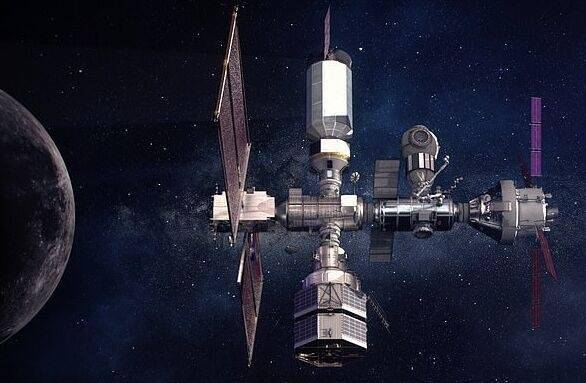Image source: NASA
NASA shared a set of pictures showing what the upcoming Lunar Gateway space station (Lunar Gateway) looks like when it launches to the moon in 2024.
NASA said the orbiting laboratory will provide astronauts with a “distant home” during their lunar trips and serve as a lunar replenishment station. This orbital laboratory can accommodate 4 people, and NASA will cooperate with existing partners of the International Space Station in Europe, Japan and Canada.
Most of the space station will be built by commercial partners and will provide a docking port for the SpaceX starship lunar lander, which will transport astronauts between the orbital base and the lunar surface.
NASA also confirmed that the platform will help solve one of the biggest problems of space travel outside the Earth’s orbit by measuring radiation levels. The radiation detection research instrument kit is planned to be launched in the first module of the multi-purpose international outpost, which will orbit in an elliptical 7-day orbit around the moon.
The “Lunar Gateway Space Station” is the core part of the “Artemis” mission. By 2024, NASA will send the first woman and a man to the moon, but this may be delayed. Most of them will be launched to the moon using NASA’s new Space Launch System rocket.
The development of the rocket is almost complete, and the first test flight will be carried out later this year or early next year, which will allow the Orion spacecraft to fly around the moon without a crew.
However, NASA announced in February that they would use SpaceX’s Falcon Heavy launch vehicle to begin construction of the “Gateway” space station. SpaceX will launch the basic modules of the Moon’s Orbital Gate, including Power and Propulsion Elements (PPE) and Residence and Logistics Outpost (HALO). They are expected to be launched to the moon in May 2024 at the earliest, but may also be October 2024 at the latest.
According to the Artemis plan for manned return to the moon, NASA hopes to use the Space Launch System rocket to send four astronauts into the Orion capsule, and then dock with the “Gateway” lunar space station.
The first manned mission will be called “Artemis 3”, and up to 4 astronauts will enter the lunar orbit in the “Orion” space capsule. If ready, they will be there and “Gateway”. “Butt.
Image source: NASA
The starship will be ready, waiting to dock with the portal to welcome the two astronauts on the last part of their journey on the surface of the moon. The idea is to make the “Portal” an intermediary, but in the initial mission, “Orion” may directly dock with the starship-if the “Portal” is not ready yet.
Astronauts will stay on the moon for a week, then board the starship to return to lunar orbit, and then take Orion back to Earth. When it starts in 2024, the “gateway” can accommodate up to 4 people, but over time, it is expected that facilities will increase and new modules will be added.
This is similar to the growth of the International Space Station, which currently has 7 personnel. Since its launch in the late 1990s, it has gradually increased from 3 to 6 people.
In the future, with the launch of the new module of the Lunar Gateway Space Station, it may become a science and exploration center far away from the Earth’s near orbit.
There will be four core modules at launch, the power and propulsion element (PPE), which was originally part of the asteroid redirection mission, but was later cancelled by the NASA Jet Propulsion Laboratory team.
Image source: NASA
It will serve as the “gateway” command and communication center and provide power to a wider range of sites. It was built by Maxar Technologies, which won a $375 million contract from NASA.
The second major module, which will be launched by SpaceX in 2024, is the Residential and Logistics Outpost (HALO), built by Northrop Grumman and headquartered in the United States. “Cygnus Cargo” (Cygnus Cargo) supply module. It will be equipped with a pair of interfaces, batteries, communication antennas and a fully pressurized cabin for command, control and data processing capabilities.
The third module, built by the European Space Agency, is called the European System Fuel Support, Infrastructure and Telecommunications (ESPRIT) module, and will also be launched in 2024. It will provide additional power, communications, airlocks and scientific capabilities for the other two core modules, built by Airbus and Thales Alenia Aerospace.
Prospective Economist APP Information Group

You must log in to post a comment.